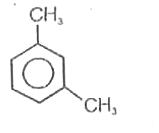What final product will form when alcoholic KOH is treated with 1,1- dirbomoethane ?
Ethene
Ethane -1, 2 - diol
Acetaldehyde
Ethyne
The correct Answer is:D
To solve the problem of what final product forms when alcoholic KOH is treated with 1,1-dibromoethane, we can follow these steps:
Step 1: Understand the structure of 1,1-dibromoethane
1,1-dibromoethane has the following structure:
- It is derived from ethane (C2H6) where both bromine atoms are attached to the first carbon atom.
- The structure can be represented as:
Br−C(Br)−C(H)−H
or more simply as:
Br−C(Br)−C(H)−H
Step 2: Reaction with alcoholic KOH
Alcoholic KOH acts as a strong base and will promote an elimination reaction (dehydrohalogenation). In this case, it will remove a hydrogen atom and a bromine atom from the molecule.
Step 3: Identify the elimination process
- The elimination will occur at the β-position (the carbon adjacent to the carbon with the leaving group).
- The base (KOH) will abstract a hydrogen atom from the β-carbon, leading to the formation of a double bond between the two carbon atoms.
Step 4: First elimination step
- The first elimination will yield an alkene (specifically, ethylene):
Br−C(Br)−C(H)KOH−−−→C=C+HBr
This results in the formation of:
C=C(H)−H
Step 5: Second elimination step
- Since alcoholic KOH is present in excess, a second elimination can occur. The base will again abstract a hydrogen from the β-carbon of the alkene formed in the first step.
- This will lead to the formation of a triple bond (alkyne):
C=C(H)KOH−−−→C≡C+HBr
Step 6: Final product
The final product after both eliminations is:
C≡C (ethyne)
Conclusion
The final product formed when 1,1-dibromoethane is treated with alcoholic KOH is ethyne (C2H2).
1,1-dibromoethane has the following structure:
- It is derived from ethane (C2H6) where both bromine atoms are attached to the first carbon atom.
- The structure can be represented as:
Br−C(Br)−C(H)−H
or more simply as:
Br−C(Br)−C(H)−H
Alcoholic KOH acts as a strong base and will promote an elimination reaction (dehydrohalogenation). In this case, it will remove a hydrogen atom and a bromine atom from the molecule.
- The elimination will occur at the β-position (the carbon adjacent to the carbon with the leaving group).
- The base (KOH) will abstract a hydrogen atom from the β-carbon, leading to the formation of a double bond between the two carbon atoms.
- The first elimination will yield an alkene (specifically, ethylene):
Br−C(Br)−C(H)KOH−−−→C=C+HBr
This results in the formation of:
C=C(H)−H
- Since alcoholic KOH is present in excess, a second elimination can occur. The base will again abstract a hydrogen from the β-carbon of the alkene formed in the first step.
- This will lead to the formation of a triple bond (alkyne):
C=C(H)KOH−−−→C≡C+HBr
The final product after both eliminations is:
C≡C (ethyne)
The final product formed when 1,1-dibromoethane is treated with alcoholic KOH is ethyne (C2H2).
Similar Questions
Knowledge Check

What is the final product T.A B
B C
C D
D
Which product is formed when tht, compound

is treated with concentrated aqueous KOH solution?A B
B C
C D
D
Which product is formed when tht, compound

is treated with concentrated aqueous KOH solution?A B
B C
C D
D
The final product formed , when alkaline Kl solution reacts with ozone and water is
View SolutionThe final product formed when methylamine is treated with NaNO2 and HCl followed by hydrolysis is :
View SolutionWhat products are formed when the following compound is treated with Br2 in the presence of FeBr3

View SolutionWhich product is formed when the compound is treated with concentrated aqueous KOH solution ?
View SolutionThe final product formed when acetaldehyde is reduced with sodium and alcohol is
View Solution
